
Black Swan – Dir. Darren Aronofsky – 2010:
When you watch certain movies over and over again, they are most probably good. When you have the urge to rewatch a movie right after seeing it for the first time, it is most certainly to be a masterpiece. Such masterpiece was created by Darren Aronofsky in 2010 in form of Black Swan. A central theme found in many of Aronofsky’s films is the examination at how far addiction will take people. Black Swan looks how far one woman will push herself in order to achieve perfection and emerge as something else. It is also about growing up: People choose when they want to mature but there is no way back to childhood.
“We all know the story. Virginal girl, pure and sweet, trapped in the body of a swan. She desires freedom but only true love can break the spell. Her wish is nearly granted in the form of a prince, but before he can declare his love her lustful twin, the black swan, tricks and seduces him. Devastated the white swan leaps of a cliff killing herself and, in death, finds freedom” (Thomas Leroy).
Nina is 28 years old and ballet means everything to her. She dances professionally in a New York City ballet company and dreams of t h e big role – playing the Swan Queen!
When we first meet Nina, she resembles a child – she lives with her mother, her bedroom looks very childish and even her name means “little girl” in Spanish.
When Thomas, Nina’s mentor, firstly announces that the production of Swan Lake is looking for a “fresh face” to play the Swan Queen, Nina is incredibly excited because she anticipated this opportunity all her entire life. At the same time, she is aware that this dream is unattainable since she is not the only superb ballet dancer – the competition is huge!
Her mentor, Thomas says that she is the perfect cast for the White Swan but she is not yet ready to embody the Black Swan.
The truth is when I look at you all I see is the white swan. Yes you’re beautiful, fearful, and fragile. Ideal casting. But the black swan? It’s a hard fucking job to dance both (Thomas Leroy).
He does not want someone who can perfectly mimic what it is like to be authentic but expects Nina to be authentic.
The situation gets even worse when all of a sudden, the character of Lily is introduced. Dressed in black mostly all of the time, flirtatious and sexy, she embodies everything that Nina isn’t. She is the perfect cast for the Black Swan.
Throughout the movie, the notion of both the White and the Black Swan represent metaphors for certain character traits. The White Swan stands for purity, innocence and childhood whereas the Black Swan represents sexuality, passion and adulthood.
Surprised by the fact that Thomas still decided to give the role to Nina, she starts to break free from her childhood repressions. She needs to shed the outer layer that she hid behind all of her life in order to truly become what she wants.
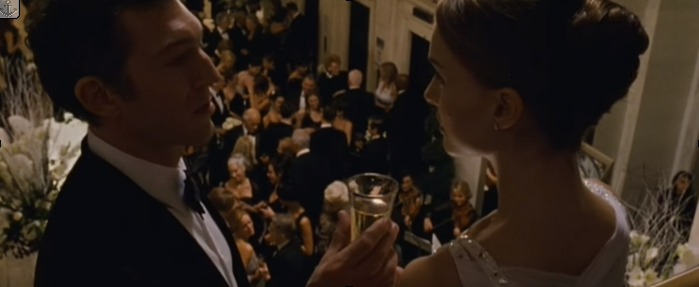
Nina finally receives the role as Swan Queen. She is wearing a white dress which can be seen as proof that, at that point, she is still a child.
When Nina receives the role, she starts growing up and adapting character traits of an apparently adult person. She offends against her own previous moral standards, disobeys and even hurts her mother, drinks alcohol, smokes and even takes drugs. After taking a pill at the nightclub, Nina fantasises about having sexual intercourse with Lily. It is not only a sexual desire that was repressed before all her entire life but rather the desire to become the Black Swan.
Lily’s tattoo resembles the wings of a swan and underlines the theory that Lily is the other Black Swan. The swan that stands in Nina’s way.

Active Black Swan (Lily) seduces the (not innocent anymore) White Swan Nina. In her imaginations, Nina and Lily are having sexual intercourse.
While “growing up”, we watch Nina slowly going crazy and transforming into the Black Swan. The moment that she becomes a Swan is after the fight with her mother. She disobeys her mother, hurts her and sets off to the play. Or more symbolically, she chooses adulthood over childhood. From now on, Nina is not a child anymore.
Soon, Nina’s condition gets worse; threatened by the continuous fear of being replaced, she slowly descends into madness. She starts seeing her doppelganger – first in strangers passing by on the streets and public transport, then in mirrors and eventually in Lily. The latter constantly gets praised by Thomas who stresses that she is the ideal candidate for the role because she is not faking to be the Black Swan. Nina realises that she needs to get rid of Lily because only then she will be able to fully become the Black Swan.
She needs to kill Lily because she is a rival – there cannot be two Black Swans – since all these thoughts are only in Nina’s head, she finally kills herself while imagining killing Lily.
This transformation into the Black Swan becomes clearly visible in the last part of the movie during the première. When it is time for her performance, she finds herself unable to play the White Swan as perfect and controlled as in the beginning. Almost all the purity, that she had, is gone and is being replaced with maturity. Once she stabs herself, one could argue that she is giving up her youthfulness.
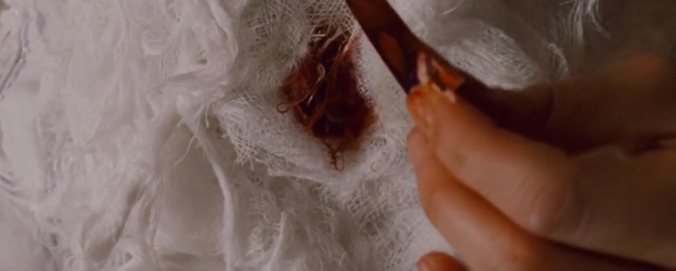
Nina realises that she did not kill Lily with the shard but herself.
This is one of the final mirror shots that we see in the film. It literally shows the idea that Nina’s befuddled reception is killing her. She is destroying the little girl inside of her. When it is time to play the role of the Black Swan, she does it perfectly.
—-
All of the hints as feathers…
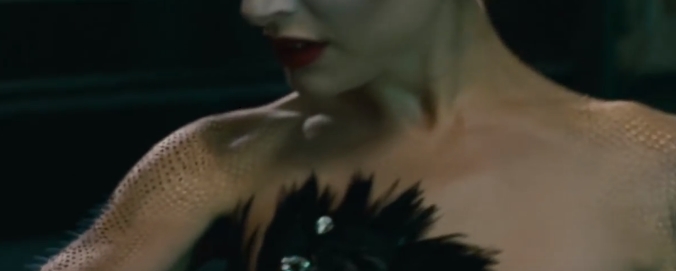
…red eyes…
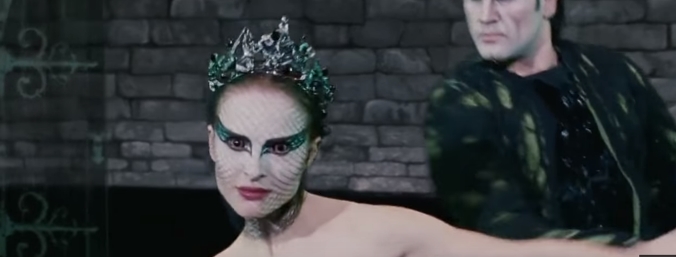
…and stretched necks that we’ve seen so far…
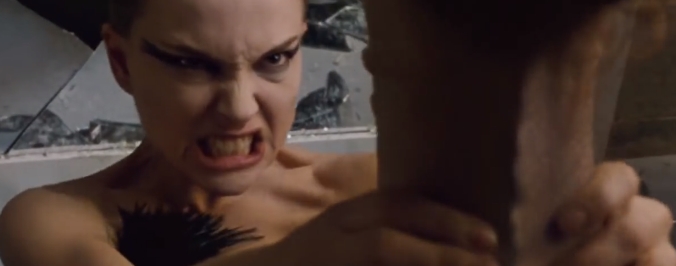
…indicate that Nina’s metamorphosis is complete.
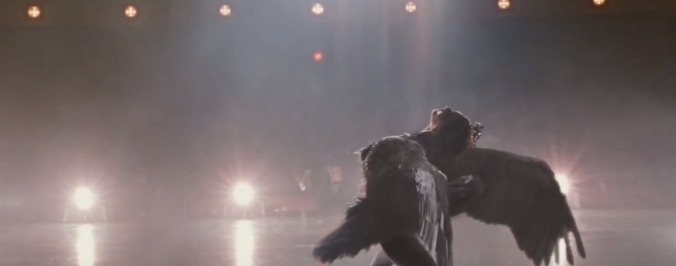
Summing up, it can be stated that the movie is about the loss of innocence. It shows that only through imperfections can perfections truly be achieved. To play the Black Swan, you have to be damaged.
Black Swan can be interpreted as a modern telling of the Swan Lake story which is basically the central focus of the film. We can draw parallels with its story (see the initial quote from Thomas) and the two main protagonists – Nina and Lily.
In the movie, we have to ballet dancers, Nina and Lilly who both represent a swan. Nina stands for the white and Lily for the black swan. In the story, they are both fighting over the prince which in the movie is the role of the Swan Queen. In the end, the White Swan dies just like Nina.
Interestingly, the film finally ends with a less traditional manner: Instead fading to black like we as viewers would traditionally expect, we see a fade to white. The Black Swan lives whereas the white swan has to die.
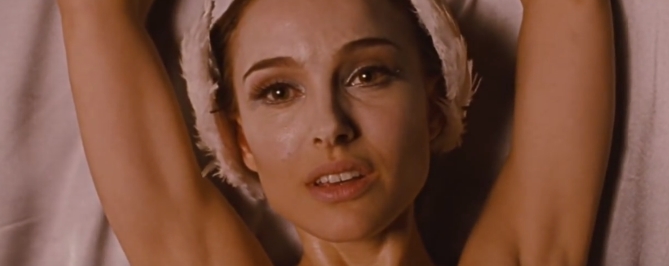
I felt it. Perfect. It was.. perfect..
Suggested further reading:
- https://laughingsquid.com/how-absolute-self-destruction-drives-obsessive-film-characters-to-achieve-absolute-perfection/
- https://bestfilmsofourlives.wordpress.com/2010/12/28/review-black-swan/
- http://movierdo.com/black-swan-psychological-analysis/
- https://www.flixist.com/deep-analysis-black-swan-197500.phtml
- https://abcnews.go.com/Health/Movies/black-swan-psychiatrists-diagnose-natalie-portmans-portrayal-psychosis/story?id=12436873